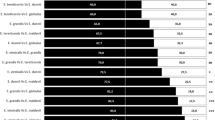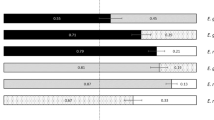Abstract
Eucalyptus displays strong intraspecific variation in resistance to browsing by marsupial folivores that can be attributed to variation in the concentration and type of diformylphloroglucinol compounds (DFPCs) in the foliage. In this study, we ask which functional groups of diformylphloroglucinol compounds determine their effectiveness in deterring feeding. We used a simple and highly deterrent compound, jensenone, as a model DFPC and compared its activity to structural variants that differ in the types of functional groups on the phloroglucinol molecule. Torquatone, a naturally occurring compound in the steam volatile fraction of Eucalyptus torquata foliage, has neither the aldehyde nor phenol groups that are believed to contribute to the antifeedant actions of jensenone. From the naturally occurring compounds we have synthesized two intermediates, a capped phenol/free aldehyde compound (acetyl-jensenone) and a free phenol/no aldehyde compound (demethyl-torquatone). Addition of jensenone and acetyl-jensenone to diets of common ringtail possums (Pseudocheirus peregrinus) substantially reduced their food intakes. Torquatone showed less activity, and there was little reduction in food intake when demethyl-torquatone was added to the diet. We conclude that at least the aldehyde groups attached to the aromatic nucleus are important in determining whether these compounds deter feeding by common ringtail possums, whereas the phenol groups may play only a minor role.
Similar content being viewed by others
REFERENCES
Ayres, M. P., Clausen, T. P., Maclean, S. F., Redman, A. M., and Reichardt, P. B. 1997. Diversity of structure and antiherbivore activity in condensed tannins. Ecology 78:1696-1712.
Boland, D. J., Brophy, J. J., and Fookes, C. J. R. 1992. Jensenone, a ketone from Eucalyptus jensenii. Phytochemistry 31:2178-2179.
Bolte, M. L., Bowers, J., Crow, W. D., Paton, D. M., Sakurai, A., Takahashi, N., Ujie, M., and Yoshida, S. 1984. Germination inhibitor from Eucalyptus pulverenta. Agric. Biol. Chem. 48:373-376.
Bolte, M. L., Crow, W. D., Sakurai, A., Takahashi, N., Ujie, M., and Yoshida, S. 1985. Structure/activity relationships of grandinol: A germination inhibitor in Eucalyptus. Agric. Biol. Chem. 49:761-768.
Bowyer, R. C., and Jefferies, P. R. 1959. Studies in plant chemistry: I. The essential oils of Eucalyptus caesia Benth. and E. torquata Leuhm. and the structure of torquatone. Aust. J. Chem. 12:442-446.
Clausen, T. P., Reichardt, P. B., and Bryant, J. P. 1986. Pinosylvin and pinosylvin methyl ether as feeding deterrents in green alder. J. Chem. Ecol. 12:2117-2131.
Cork, S. J. 1992. Polyphenols and the distribution of arboreal folivorous marsupials in Eucalyptus forests of Australia, pp. 653-663, in R. W. Hemmingway (ed.). Plant Polyphenols: Synthesis, Properties, Significance. Plenum Press, New York.
Dearing, M. D. 1997. Effects of Acomastylis rossii tannins on a mammalian herbivore, the North American Pika, Ochotona princeps. Oecologia 109:122-131.
Foley, W. J., Lassak, E. V., and Brophy, J. 1987. Digestion and absorption of Eucalyptus essential oils in greater glider (Petauroides volans) and brushtail possum (Trichosurus vulpecula). J. Chem. Ecol. 13:2115-2130.
Ghisalberti, E. L. 1996. Bioactive acylphloroglucinol derivatives from Eucalyptus species. Phytochemistry 41:7-22.
Ghisalberti, E. L., Skelton, B. W., and White, A. H. 1995. Structural study of torquatone, an acylphloroglucinol derivative from Eucalyptus species. Aust. J. Chem. 48:1771-1774.
Hillis, W. E. 1996. Variation in polyphenol composition within species of Eucalyptus L'Herit. Phytochemistry 5:541-556.
Hodar, J. A., and Palo, R. T. 1997. Feeding by vertebrate herbivores in a chemically heterogeneous environment. Ecoscience 4:304-310.
Hume, I. D., and Esson, C. 1993. Nutrients, antinutrients and leaf selection by captive koalas (Phascolarctos cinereus). Aust. J. Zool. 41:379-392.
John, J. A., and Williams, E. R. 1995. Cyclic and Computer Generated Designs. Chapman Hall, London.
Kool, K. M. 1992. Food selection by the silver leaf monkey, Trachypithecus auratus sondaicus, in relation to plant chemistry. Oecologia 90:527-533.
Lawler, I. R., Foley, W. J., Eschler, B. M., Pass, D. M., and Handasyde, K. 1998a. Intraspecific variation in Eucalyptus secondary metabolites determines food intake by folivorous marsupials. Oecologia 116:160-169.
Lawler, I. R., Foley, W. J., Pass, G. J., and Eschler, B. M. 1998b. Administration of a 5HT3 receptor antagonist increases the intake of diets containing Eucalyptus secondary metabolites by marsupials. J. Comp. Physiol. B 168:611-618.
Lawler, I. R., Foley, W. J., and Eschler, B. M. 1999a. Foliar concentration of a single toxin creates habitat patchiness for a marsupial folivore. Ecology. In press.
Lawler, I. R., Stapley, J., Foley, W. J., and Eschler, B. M. 1999b. Ecological example of conditioned flavor aversion in plant-herbivore interactions: Effect of terpenes of Eucalyptus on feeding by common ringtail and brushtail possums J. Chem. Ecol. 25:401-415.
McArthur, C., and Sanson, G. D. 1993. Nutritional effects and costs of a tannin in two marsupial arboreal folivores. Funct. Ecol. 7:697-703.
Murata, M., Yamakoshi, Y., Homma, S., Aida, K., Hori, K., and Ohashi, Y. 1990. Macrocarpal A, a novel antibacterial compound from Eucalyptus macrocarpa. Agric. Biol. Chem. 54:3221-3226.
Oates, J. F., Waterman, P. G., and Choo, G. M. 1980. Food selection by the South Indian leaf-monkey, Presbytis johnii, in relation to leaf chemistry. Oecologia 45:45-56.
Osawa, K., Yasuda, H., Morita, H., Takeya, K., and Itokawa, H. 1996. Macrocarpals H, I, and J from the leaves of Eucalyptus globulus. J. Nat. Prod. 59:823-827.
Pass, D. M., Foley, W. J., and Bowden, B. 1998. Vertebrate herbivory on Eucalyptus—identification of specific feeding deterrents for common ringtail possums (Pseudocheirus peregrinus) by bioassay-guided fractionation of Eucalyptus ovata foliage. J. Chem. Ecol. 24:1513-1527.
Provenza, F. D., Burrit, E. A., Clausen, T. P., Bryant, J. P., Reichardt, P. R., and Distel, R. A. 1990. Conditioned flavor aversion: A mechanism for goats to avoid condensed tannins in blackbrush. Am. Nat. 136:810-828.
Singh, I. P., Takahashi, K., and Etoh, H. 1996. Potent attachment-inhibiting and-promoting substances for the blue mussel, Mytilus edulis galloprovincialis, from two species of Eucalyptus. Biosci. Biotechnol. Biochem. 60:1522-1523.
Takasaki, M., Konoshima, T., Fujitani, K., Yoshida, S., Nishimura, H., Tokuda, H., Nishino, H., Iwashima, A., and Kozuka, M. 1990. Inhibitors of skin-tumor promotion. VIII. Inhibitory effects of euglobals and their related compounds on Epstein-Bar virus activation. Chem. Pharm. Bull. 38:2737-2739.
Waterman, P. G., and Kool, K. M. 1994. Colobine food selection and plant chemistry, pp. 251-284, in A. G. Davies and J. F. Oates (eds.). Colobine Monkeys: Their Ecology, Behaviour, And Evolution. Cambridge University Press, Cambridge.
Yamakoshi, Y., Murata, M., Shimizu, A., and Homma, S. 1992. Isolation and characterization of macrocarpals B–G, antibacterial compounds from Eucalyptus macrocarpa. Biosci. Biotechnol. Biochem. 56:1570-1576.
Zucker, W. V. 1983. Tannins: does structure determine function? An ecological perspective. Am. Nat. 121:335-365.
Author information
Authors and Affiliations
Rights and permissions
About this article
Cite this article
Lawler, I.R., Bart, Eschler, M. et al. Relationship Between Chemical Functional Groups on Eucalyptus Secondary Metabolites and their Effectiveness as Marsupial Antifeedants. J Chem Ecol 25, 2561–2573 (1999). https://doi.org/10.1023/A:1020834510532
Issue Date:
DOI: https://doi.org/10.1023/A:1020834510532




